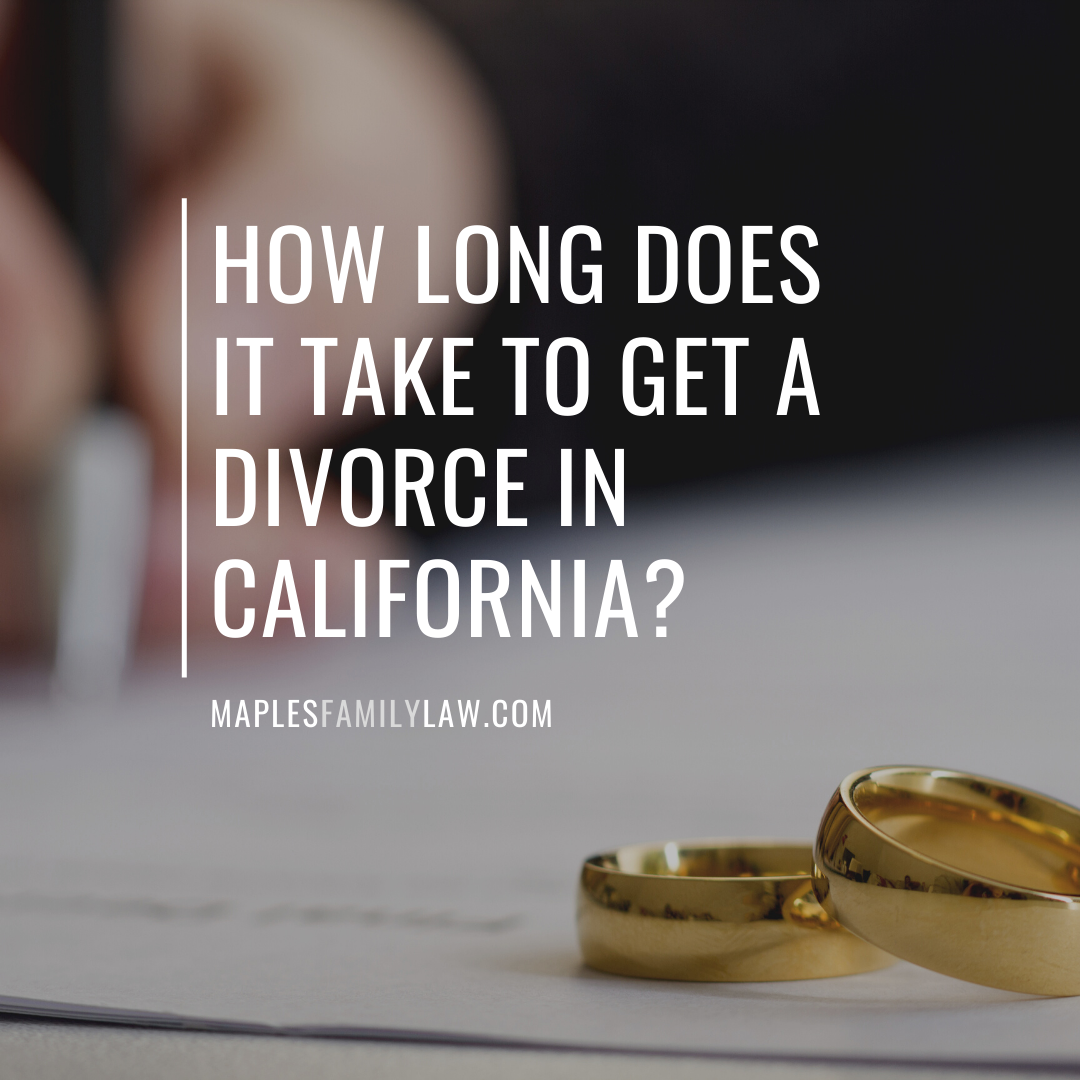 Divorce
Divorce
Getting a Divorce in California? Your Step-by-Step Guide
Table of Contents
One of the hardest parts about getting divorced is actually making the decision. Once you’ve made that emotional commitment, though, you might be left wondering what happens next?
If that sounds like you, then you’re not alone. Divorce can be a daunting process—particularly if it’s your first time. Each step has its own rules, regulations, and timelines, which must be followed correctly if you want the best results.
To help you get started, here’s what you need to know about how to get divorced in California, and what Maples Family Law can do to help you navigate each of these important steps.

How to Get Divorced in California
No two relationships are ever the same; this means that breakups aren’t, either, and your process will vary, according to what type of divorce you choose, as well as your own particular needs.
That being said, most California divorces will require you to take these eight basic steps:
- Meet state and county residency requirements.
- Establish your grounds.
- File the correct paperwork with your county clerk.
- Execute proper service on your spouse.
- Wait for a response.
- Endure California’s mandatory waiting period.
- Attend either a settlement hearing or a trial.
- Receive your final divorce order.
Here’s a closer look at each phase, and what you can expect from each one.
Step #1: Residency Requirements
You can’t file for divorce in California, unless you live in California. Hence, before you file for divorce, you should double check to make sure you meet the residency requirements.
In California, this means that at least one of you must have been a resident of the state for six months, prior to filing. (On the county level, this requirement is three months).
Exception: Same sex spouses may have this residency requirement waived, if:
- Their marriage took place in California; and,
- Neither spouse lives in a state that recognizes same sex marriage.
In other words, if a same sex couple wants a divorce—but they live in a state that doesn’t recognize their union—then California courts are willing to grant them a divorce, so long as the marriage originally took place in California.
Step #2: Establish Grounds
The next step is to determine what grounds you want to file under.
In legal speak, divorce grounds are essentially the reason you want to get divorced. They tell the court why you want to dissolve your marriage, and are a required part of your divorce complaint.
Luckily, California has long since done away with the toxicity of fault-based divorces. This means you simply need to choose from one of two, no-fault divorce grounds:
- Irreconcilable differences; or,
- Permanent legal incapacity.
While both are no-fault options, the second requires proof of expert medical or psychiatric testimony as to the incapacity. Hence, most California couples choose to file under irreconcilable differences, since it’s much simpler.
Step #3: File Paperwork
Once your divorce complaint is finished, you will need to file it (and any subsequent documents) with your county clerk. Part of this step includes paying a filing fee.
While filing fees vary by county, in California, it’s typical for it to cost somewhere between $435-$450. If you’ve hired an attorney, then they’ll likely take care of this for you, using funds from your retainer account.
Mistakes can be a headache, causing unnecessary delays and additional expense, so be sure to review your paperwork carefully, before filing anything.
Step #4: Execute Proper Service
Due process is a legal concept that—among other things—gives someone the right to defend themselves in court. In order to uphold this important principle, you will need to notify your spouse that you’ve filed for divorce.
Keep in mind, however, that a casual text or phone call won’t cut it here. In order to be valid, this notice must be carried out a certain way—a process known as proper service.
Most of the time, this is done by having someone other than yourself hand-deliver copies of your divorce paperwork to your spouse. However, other options are available in situations where that isn’t feasible.
Step # 5: Wait for Response
Once you’ve successfully executed proper service on your spouse, your spouse will have thirty days to file an answer with the court.
An answer is a legal document that addresses the terms laid out in your original divorce complaint, and it typically arrives in one of three ways. For example, your spouse may:
- Respond by agreeing to all of your terms.
- Respond by disputing the merits of some or all of your claims (and offering subsequent counter arguments, in return).
- Not responding at all.
Most California defendants fall under option two; however, if your divorce is uncontested, then it may be category one. The last option (not responding at all) is the least common of all the response methods, and will generally result in a default divorce.
Step: #6: Mandatory Waiting Period
Unfortunately, even if your spouse agrees on everything, you still won’t be able to just up and get a divorce the next day. Indeed, according to California law, couples who file for divorce must undergo a mandatory six-month waiting period, before their split can be finalized.
This unofficial “time out” acts as a cooling off period, and gives couples the opportunity to reconcile (which actually happens more often than you might think). However, just because a judge can’t finalize your divorce, doesn’t mean you have to be idle.
Waiting periods are a good time to try an out of court negotiation process, such as divorce mediation, or collaborative divorce. These alternative dispute resolution methods are less expensive than a full trial, and offer couples a lot more flexibility in determining the terms of their final order.
While it’s sometimes possible to finalize things before six-months are over, most divorces take an average of eight months to a year to fully complete.
Step #7: Settlement Hearing or Trial
After the waiting period, you and your spouse will need to attend either a settlement hearing, or start preparing for trial.
If your out-of-court negotiations were successful, then your agreement (including important issues like alimony, property, and debt) will be codified into what’s known as a settlement agreement.
This document is then presented to the judge for formal approval, which will take place during your settlement hearing. So long as your agreement meets all the mandatory requirements (for example, child support minimums), judges typically have no problem signing it into a final order.
If your negotiations were not successful, however, then you and your spouse should begin preparing for trial—assuming you haven’t done so already. At trial, your judge will hear arguments and review evidence presented by both sides, and make decisions on your behalf.
Trials are (by far) the least appealing way to get a divorce, since they are much more expensive, time consuming, and offer the least amount of control over decision making. Hence, we suggest doing whatever you can to make mediation successful, and avoid it altogether.
Step #8: Receive Your Final Order
A final decree encompasses all the terms of your divorce, and—once signed and authorized by your judge—it means you are officially no longer married.
You will receive this final order at the end of either your settlement hearing or divorce trial (whichever you ended up doing). Once received, you’ll need to file a copy with the county clerk on your way out.
The terms contained in a final order are not optional. Failure to comply with them can result in some serious legal and/or financial consequences, including contempt of court, so it’s best not to test the limits.
If you are having a legitimate problem complying with your order, then it’s best to speak to a family law attorney about your options, since you may be able to modify it.
Do You Have Questions About How to Get Divorced in California?
Nothing is ever quite as daunting as staring down the uncertainty of an oncoming divorce. And while this process is sure to have its ups and downs, the good news is that with an experienced family law attorney, it may not have to be as bad as you’re thinking.
For more questions about how to get divorced in California—including what that might look like in your situation—we want to hear from you. Call the Maples Family Law team at (209) 910-9865 or get in touch online, and let us help you make this important life transition.
Getting a Divorce in California? Your Step-by-Step Guide
https://youtu.be/LUBE18kR0v0 How to Get Divorced in CaliforniaStep #1: Residency Requirements Step #2: Establish GroundsStep #3: File…
Who Gets the Rings in a California Divorce? Learn the 3 Key Factors Now | Maples Family Law
Anna Y. Maples, Family Law Attorney ExplainsWho Gets the Wedding or Engagement Rings if You…
Divorce Stress: How 2 Navigate the Storm
1. Emotional Turmoil2. Financial Strain3. Child Custody Battles5. Legal Complexities6. Coping with Stress During Divorce…
8 Steps to Get a Divorce in California: The Ultimate Guide
Guide 4 Divorce in California Considering a divorce in California? You will want to know…
Divorce Litigation in CA
Divorce Litigation in CA In California, divorce litigation is a type of contested divorce. This…
What is a Divorce Settlement Agreement?
What is a Divorce Settlement Agreement? Never, in the history of love, has ever been…





























